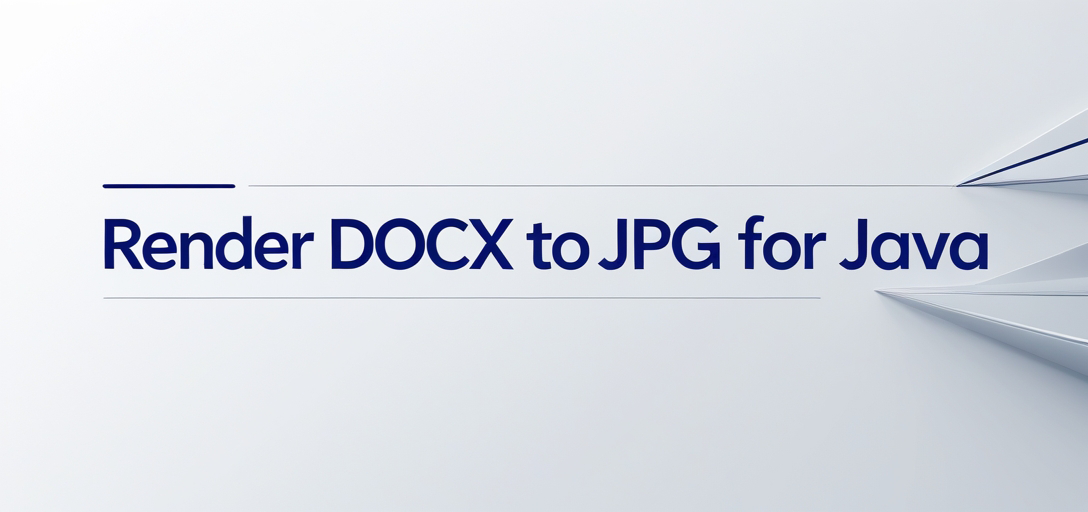How to Render a DOCX Document to JPG Images Using GroupDocs.Viewer for Java
Introduction
Converting document pages into image files can simplify sharing and presentation. Rendering documents as images is particularly useful in web applications or digital archives. This tutorial will guide you through using GroupDocs.Viewer for Java to transform each page of a DOCX file into individual JPG images.

In this comprehensive guide, you’ll learn how to:
- Set up and configure GroupDocs.Viewer for Java.
- Convert document pages into high-quality JPG images.
- Optimize performance and troubleshoot common issues during implementation.
Prerequisites
Before you begin rendering your documents, ensure that your development environment is ready. You’ll need:
- Java Development Kit (JDK): Version 8 or later.
- Integrated Development Environment (IDE): Such as IntelliJ IDEA or Eclipse.
- Maven: For managing dependencies and building the project.
Familiarity with Java programming and basic understanding of Maven projects will be beneficial, but not necessary. Now that you’re equipped with the prerequisites, let’s set up GroupDocs.Viewer for Java.
Setting Up GroupDocs.Viewer for Java
To start using GroupDocs.Viewer in your Java application, add it as a dependency in your project:
<repositories>
<repository>
<id>repository.groupdocs.com</id>
<name>GroupDocs Repository</name>
<url>https://releases.groupdocs.com/viewer/java/</url>
</repository>
</repositories>
<dependencies>
<dependency>
<groupId>com.groupdocs</groupId>
<artifactId>groupdocs-viewer</artifactId>
<version>25.2</version>
</dependency>
</dependencies>
Once you’ve added the dependency, download and install GroupDocs.Viewer by running mvn clean install.
License Acquisition
You can access a free trial or request a temporary license from the GroupDocs website. For production use, consider purchasing a full license.
After setting up the library in your project, it’s time to move on to implementing the feature that converts DOCX documents into JPG images using GroupDocs.Viewer.
Implementation Guide
In this section, we will break down the process of rendering a document page by page as JPG images with GroupDocs.Viewer for Java.
Overview: Rendering Document Pages as Images
This functionality allows you to convert each page of your DOCX file into an individual image, making it easier to handle and display documents in various applications.
Step 1: Setting Up the Environment
Firstly, ensure that your output directory is correctly set up to store the resulting images:
Path outputDirectory = Paths.get("YOUR_OUTPUT_DIRECTORY");
This path will be used to save each page image with a unique filename format.
Step 2: Configuring View Options
Next, configure the options for rendering:
// Configure JPG view options with the output file path pattern.
Path pageFilePathFormat = outputDirectory.resolve("page_{0}.jpg");
JpgViewOptions viewOptions = new JpgViewOptions(pageFilePathFormat);
The JpgViewOptions class allows you to specify how document pages are rendered as images. The {0} in the file path format will be replaced by page numbers.
Step 3: Rendering Pages
Now, it’s time to render each document page:
try (Viewer viewer = new Viewer("YOUR_DOCUMENT_DIRECTORY/SAMPLE_DOCX")) {
// Render the document pages into JPG images.
viewer.view(viewOptions);
}
The Viewer class is used here to load your DOCX file. The view() method renders the document using the specified options.
Key Configurations
- Output Directory: Make sure it exists and has write permissions.
- File Naming Format: Customize this format if needed for better organization or integration with other systems.
Troubleshooting Tips
- Ensure that all dependencies are correctly resolved in your Maven project.
- Verify file paths to avoid
FileNotFoundException. - Check the GroupDocs.Viewer version compatibility with your Java environment.
Practical Applications
Rendering documents as images has numerous practical applications:
- Web Portals: Display document previews without requiring users to download entire files.
- Document Management Systems (DMS): Implement quick access and searching features using thumbnails.
- Archiving Solutions: Create immutable, easily shareable copies of critical documents.
Integration with web frameworks like Spring Boot or Java EE can further enhance the capabilities by leveraging REST APIs for document processing tasks.
Performance Considerations
To ensure optimal performance when rendering large documents:
- Use efficient memory management techniques to prevent excessive resource usage.
- Consider multi-threading for rendering multiple pages concurrently if your application requires high throughput.
- Regularly update GroupDocs.Viewer to benefit from performance improvements in newer versions.
Adhering to these best practices will help maintain a responsive and stable application environment.
Conclusion
You’ve now mastered the process of converting DOCX documents into JPG images using GroupDocs.Viewer for Java. This powerful feature opens up many possibilities for handling document rendering tasks efficiently.
As next steps, explore other document formats supported by GroupDocs.Viewer or delve deeper into its customization options to tailor the output according to your needs.
Try implementing this solution in your projects and experience firsthand how it streamlines document management processes.
FAQ Section
- How do I change the image quality of the rendered JPGs?
- Adjust the
JpgViewOptionssettings for quality control.
- Adjust the
- Can I render other file formats besides DOCX?
- Yes, GroupDocs.Viewer supports various document types including PDF, XLSX, and more.
- What if I encounter rendering errors with specific documents?
- Ensure the document is not corrupted and check compatibility with the current viewer version.
- Is it possible to render only selected pages of a document?
- Yes, configure page numbers within
JpgViewOptionsto specify which pages to render.
- Yes, configure page numbers within
- How can I integrate this feature into an existing Java application?
- Use GroupDocs.Viewer as a library component and follow the integration guidelines provided in its documentation.
Resources
For further reading and support: